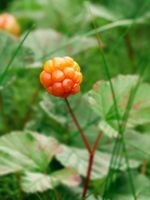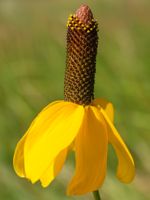Mon-Fri 9am - 5pm Mountain time
Cloudberry vs Upright Prairie Coneflower
Rubus chamaemorus
Ratibida columnifera
NOT AVAILABLE THIS SEASON - MIGHT RETURN
NOT AVAILABLE THIS SEASON - MIGHT RETURN
Cloudberry produces berries which taste tart and tangy with a sweet, floral hint. The berries have a creamy texture when overripe. They are often used to make jams, juices, and liquors. The berries are a pale red colour and when ripe turn more orange/amber. They do not grow very tall, generally reaching only 10-25 cm.
Cloudberry has distinct male and female plants. In order to produce berries, both must be present and pollinate with each other. Berries are produced at maturity, typically 5-7 years, and produce 1 berry per stem. The plant spreads naturally as they grow using modified underground stems (rhizomes), forming more plants over time in the same area.
This plant can be found wild in Canada’s boreal forest. In Newfoundland and Labrador, this plant is known as the Bakeapple and is a significant regional food. Similarly the Côte-Nord region of Quebec also has a long history of using this berry.
Note: Cloudberries require very specific soil conditions. They need well-drained soil with a pH between 3.5 and 5.0. Also sensitive to salt and dry conditions.
Note: Our seedlings are grown from seed and are too young to identify their sex.
Upright Prairie Coneflower is a native perennial wildflower known for its vibrant flowers, which range from golden yellow to dark rust-red with yellow edges. Rising on tall, slender stems, the flowers’ drooping petals surround a central cone. They bloom from midsummer into fall, attracting butterflies, bees, and other pollinators. After blooming, the florets on the cone eventually develop into seeds, which provide a food source for birds.
Its upright growth habit allows it to grow in clusters, creating a striking display. Due to its deep taproot, Upright Prairie Coneflower is drought tolerant, making it well suited to dry areas and xeriscape gardens. Low-maintenance and deer-resistant, this wildflower is a great choice for adding vibrant color and ecological value to any landscape.

